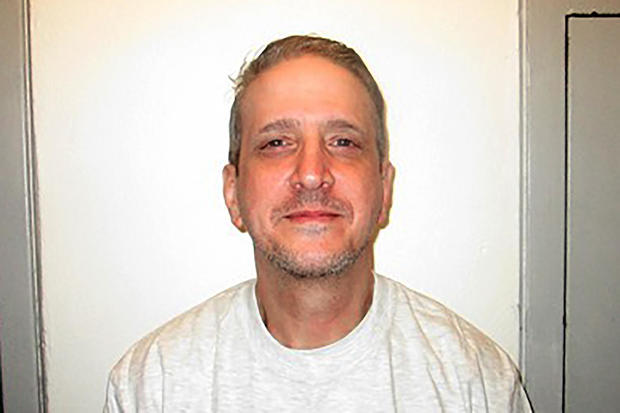Sean Murphy / AP
McAlester Okla. — Anti-death penalty advocate Lea Rodger says she’s keenly aware of the realities facing her and Richard Glossip, who she married this week inside the Oklahoma State Penitentiary — where he sits on death row.
Glossip, 59, already has narrowly escaped execution three times and could be the next man Oklahoma puts to death now that the state has lifted a nearly seven-year moratorium on executions put in place due to mishaps in his case and others.
Rodger, 32, a paralegal who has spent more than a decade advocating for an end to capital punishment, says that’s one of the reasons she didn’t want to waste time marrying her new husband.
“For Rich, surviving three execution attempts, possibly facing a fourth, the one thing he’s really taken away from that is: Don’t take anything for granted … really live in the moment,” Rodger told The Associated Press before they wed Tuesday in a small ceremony inside the Oklahoma State Penitentiary.
“I think both of us do a good job at that, and that’s why it was important to us that we do this now while we know we can make this commitment with each other,” said Rodger, of Lutz, Florida, who is now a law student.
In a statement provided to the AP, Glossip said: “After all I have been through, losing so much of my life and everyone in it, I have been blessed beyond all imagination.”
Oklahoma Department of Corrections via AP)
Although marriages of death row inmates don’t happen often, they aren’t completely unusual either, said Robert Dunham, executive director of the Death Penalty Information Center. He said the U.S. Supreme Court’s ruling in Loving v. Virginia, which prohibits bans on interracial marriages, has since been applied to people in prison.
“Marriage is among the fundamental personal rights that prisoners retain,” Dunham said.
Some of the most notorious inmates in the country have married after being imprisoned. Convicted serial killer Ted Bundy married his fiance while on death row in Florida. Erik Menendez and his brother, Lyle Menendez, serving life sentences for murdering their parents in 1989 in their Beverly Hills mansion, both were married in prison. Richard Ramirez, the demonic serial killer known as the Night Stalker who left satanic signs at murder scenes and mutilated victims’ bodies during a reign of terror in the 1980s, wed while on death row in California.
In Oklahoma, marriage ceremonies for people who are incarcerated are conducted twice a year, in March and September. The inmate or fiancee is responsible for all costs associated with the marriage, including court fees and, if necessary, transportation costs if the county requires the couple to sign the county’s marriage record book. Oklahoma does not allow conjugal visits, even for newly married inmates, but Rodger said they were able to hold hands and kiss during Tuesday’s ceremony.
It is the second prison marriage for Glossip, who filed for divorce from his first wife, Leigha Joy Jurasik, of New Jersey, who he married in 2018 when Jurasik was 21. They divorced last year, and court records show Jurasik didn’t show up to a hearing last year in which a judge ordered her to pay Glossip $100 per week for 85 weeks to cover a $5,000 alimony award and $3,500 for Glossip’s legal fees. Jurasik didn’t respond to a voicemail and messages seeking comment on her marriage to Glossip.
Glossip: a prisoner of note
Glossip is perhaps best known for the landmark U.S. Supreme Court case that bears his name. In 2015, a split court found constitutional the use of the sedative midazolam in lethal injections.
Glossip’s case attracted international attention after actress Susan Sarandon – who won an Academy Award for her portrayal of death penalty opponent Sister Helen Prejean’s fight to save a man on Louisiana’s death row in the 1995 movie “Dead Man Walking” – took up his cause in real life. Prejean herself has served as Glossip’s spiritual adviser and frequently visited him in prison.
Glossip was twice convicted and sentenced to die for ordering the January 1997 killing of Barry Van Treese, who owned the Oklahoma City motel where Glossip worked. Prosecutors said Justin Sneed, a motel handyman, admitted robbing and beating Van Treese, but said he did so only after Glossip promised to pay him $10,000. Sneed, who was the key witness against Glossip at both of his trials, is currently serving a life sentence without parole.
Glossip has twice been within hours of receiving a lethal injection when his execution was called off. He got a two-week reprieve in September 2015 to allow his lawyer time to pursue an innocence claim. Two weeks later, after a court rejected that, he was about to be escorted to the execution chamber when prison officials realized they had received the wrong drug for his execution. That led to a nearly seven-year moratorium on the death penalty in Oklahoma that ended last fall. Now, he is the lead plaintiff in a federal lawsuit again challenging the state’s lethal injection method as unconstitutional. Another lawyer, Don Knight, is seeking to overturn his conviction based on a claim of innocence.
Sheila Isenberg, who recently finished a second edition of her 1991 book, “Women Who Love Men Who Kill,” and has extensively interviewed women who seek relationships with convicted killers, as well as psychiatrists, social workers and prison officials, said some women are attracted to men who commit particularly heinous crimes, such as serial killers or mass murderers.
“In Richard Glossip’s case, he is neither a serial killer nor a mass murderer, but he is nevertheless notorious,” Isenberg said.
Rodger bristled at the suggestion that Glossip’s notoriety is what attracted her to him. She said she never even considered marriage when she added Glossip to a list of prisoners she sends Christmas cards to each year.
Ultimately, correspondence via letters gave way to phone calls, and Rodger said she and Glossip quickly developed a deep connection.
“We had that instant comfort with each other, like you’ve known someone your whole life,” she recalled.
“This isn’t about attention,” she continued. “I’m a very private person. It just happens to be the circumstances that we’re in. I believe the attention should be focused on his innocence. He has already lost 25 years of his life.”

